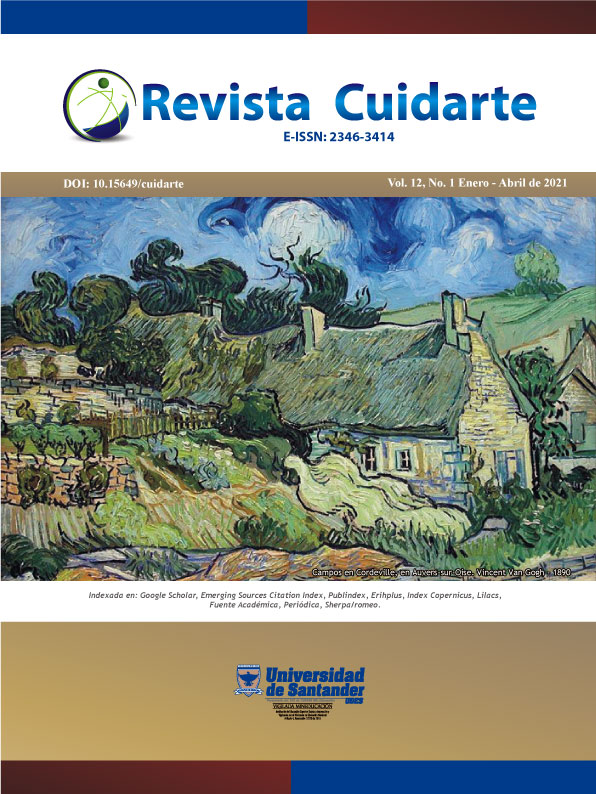Factores epidemiológicos Ro y Re durante la COVID-19: ¿qué son y en qué difieren?
DOI:
https://doi.org/10.15649/cuidarte.1393Palabras clave:
Infecciones por Coronavirus, EpidemiologíaResumen
Las enfermedades infecciosas son aquellas causadas por microbios patógenos como algunas bacterias, virus, parásitos, entre otros. Estas enfermedades pueden transmitirse, directa o indirectamente, de un individuo a otro 1.
La epidemiología estudia los procesos de salud y enfermedad que afectan a las poblaciones. Se interesa por conocer las características de los grupos que se ven afectados; cómo se distribuyen geográficamente y en el tiempo los eventos de salud y enfermedad; con qué frecuencia se manifiestan y cuáles son las causas o factores asociados a su surgimiento 2.
Como citar este artículo: Comincini Cantillo Eric, Wilches Visbal Jorge Homero, Saraví Fernando Daniel. Factores epidemiológicos R0 y Re durante la COVID-19: ¿qué son y en qué difieren?. Revista Cuidarte. 2021;12(1):e1290. http://dx.doi.org/10.15649/cuidarte.1290
Referencias
Organización Mundial de la Salud. Infectious Diseases [Internet]. 2020 [citado 18 de julio de 2020]. Disponible en: https://www.who.int/topics/infectious_diseases/es/#:~:text
Organización Mundial de la Salud. Epidemiología [Internet]. 2020 [citado 18 de julio de 2020]. Disponible en: https://www.who.int/topics/epidemiology/es/
Organización Mundial de la Salud. Novel Coronavirus - China [Internet]. 2020 [citado 19 de julio de 2020]. Disponible en: https://www.who.int/csr/don/12-january-2020-novel-coronavirus-china/en/
Dubé C, Garner G, Stevenson M, Sanson R, Estrada C, Willeberg P. Utilización de modelos epidemiológicos para la gestión de las enfermedades animales. En: Conf OIE. 2007. p. 25-35. Disponible en: https://www.oie.int/doc/ged/D4533.PDF .
Aronson JK, Brassey J, Mahtani KR. “When will it be over?”: An introduction to viral reproduction numbers, R0 and Re [Internet]. Centre for Evidence-Based Medicine, Nuffield Department of Primary Care Health Sciences, University of Oxford. 2020. p. 1-9. Disponible en: https://www.cebm.net/wp-content/uploads/2020/04/“When-will-it-be-over_”_-An-introduction-to-viral-reproduction-numbers-1.pdf
Delamater PL, Street EJ, Leslie TF, Yang YT, Jacobsen KH. Complexity of the basic reproduction number (R0). Emerg Infect Dis [Internet]. 2019;25(1):1-4. Disponible en: https://doi.org/10.3201/eid2501.171901
Ridenhour B, Kowalik JM, Shay DK. El número reproductivo básico (R0): Consideraciones para su aplicación en la salud pública. Am J Public Health. 2018;108(1):S455-65. https://doi.org/10.2105/AJPH.2013.301704s
Van den Driessche P. Reproduction numbers of infectious disease models. Infect Dis Model. 2017;2(3):288-303. https://doi.org/10.1016/j.idm.2017.06.002
Manrique Abril FG, Agudelo Calderón CA, González Chordá VM, Gutiérrez Lesmes O, Téllez Piñerez CF, Herrera Amaya G. Modelo SIR de la pandemia de COVID-19 en Colombia. Rev Salud Pública 2020;22(1):1-9. https://doi.org/10.15446/rsap.v22n2.85977
Nishiura H, Chowell G. The effective reproduction number as a prelude to statistical estimation of time-dependent epidemic trends. En: Mathematical and Statistical Estimation Approaches in Epidemiology. 2009. p. 103-21. https://doi.org/10.1007/978-90-481-2313-1_5
Instituto Nacional de Salud. Número reproductivo efectivo nacional [Internet]. 2020 [citado 20 de julio de 2020]. Disponible en: https://www.ins.gov.co/Direcciones/ONS/modelos-de-estimacion
Publicado
Cómo citar
Descargas
Licencia
Journal Cuidarte, scientific publication of open access, is licensed under a Creative Commons Attribution (CC BY-NC), which permits use, distribution and reproduction in any medium, provided the original work is properly cited and is not used for commercial purposes.
Any other form of use such as reproduction, transformation, public communication or distribution, for profit, requires the prior authorization of the University of Santander UDES.
The names and e-mail addresses entered in the Journal Cuidarte will be used exclusively for the purposes stated by this magazine and will not be available for any other purpose or other person.
The articles published in the Journal Cuidarte represent the criteria of their authors and do not necessarily constitute the official opinion of the University of Santander UDES.




